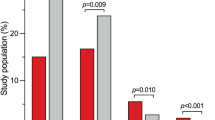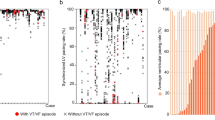Summary
Identification of high risk patients with coronary artery disease (CAD) prone to sudden cardiac death still remains a difficult issue. In 211 patients with CAD diagnosed by coronary angiography and documented non-sustained ventricular tachycardia (NSVT), programmed ventricular stimulation (PVS) was performed. NSVTs documented during Holter monitoring were analysed concerning frequency, duration and rate. To relate those parameters to the inducibility of sustained monomorphic ventricular tachycardias (MVT) during PVS, the total population was divided in different groups; patients with 1, 2–5 or >5 salvos within 24 h; patients having salvos with a rate of ≥150/min or <150/min; patients with 3–5, 6–10 or >10 consecutive extra beats. It could be demonstrated that in patients with CAD and NSVTs, induction of MVTs during PVS is more likely if the rate of the spontaneously occurring NSVT is ≥150/min (22.1 vs 8.9%; p=0.042). In contrast, there is apparently no correlation between the duration and incidence of NSVTs and the prevalence of MVTs during PVS. Multivariate analysis revealed the rate of documented NSVTs (odds ratio 2.98, p=0.0314) and a decrease of left ventricular ejection fraction (odds ratio 1.69; p=0.0013) as independent risk factors for the inducibility of MVTs. Conclusions CAD patients with fast salvos (≥150 beats/min) and reduced left ventricular ejection fraction are more likely to reveal inducible MVT during PVS and should, therefore, preferably be subjected to invasive risk stratification. The number of salvos per day and the number of consecutive beats, on the other hand, do not seem to be of relevant predictive value.
Zusammenfassung
Die Risikostratifizierung von Patienten mit koronarer Herzerkrankung (KHK) und nicht anhaltenden ventrikulären Tachykardien (NSVTs) stellt weiterhin ein klinisches Problem dar. Die Induzierbarkeit monomorpher ventrikulärer Tachykardien (MVT) während programmierter ventrikulärer Stimulation (PVS) wurde bei 211 Patienten mit angiographisch gesicherter KHK und NSVTs untersucht, wobei eine Unterteilung in verschiedene Gruppen erfolgte: Patienten mit einer, 2–5 oder >5 Salven innerhalb von 24 h; Patienten mit einer Frequenz der Salven ≥150/min oder <150/min, Patienten mit 3–5, 6–10 oder >10 konsekutiven Extrasystolen. Es fand sich eine signifikant höhere Induktionsrate von MVTs bei Patienten mit schnellen (≥150/min) NSVTs als bei Patienten mit langsamen NSVTs (<150/min) (22,1 vs 8,9%; p=0,042). Im Gegensatz dazu ergab sich keine Korrelation zwischen der Häufigkeit der NSVTs bzw. der Anzahl konsekutiver Schläge und der Induzierbarkeit von MVTs. In der multivariaten Analyse konnten die Frequenz der Salven (odds ratio 2,98, p=0,0314) und eine eingeschränkte linksventrikuläre Pumpfunktion (odds ratio 1,69; p=0,0013) als unabhängige Prädiktoren für die Induzierbarkeit von MVTs identifiziert werden. Zusammenfassung Aufgrund der deutlich höheren Rate an induzierbaren MVTs bei Patienten mit schnellen Salven scheint für dieses Kollektiv die Durchführung einer PVS gerechtfertigt. Im Gegensatz dazu ist die Häufigkeit und die Dauer einer NSVT ohne relevanten prädiktiven Wert für das Ergebnis der PVS.
Similar content being viewed by others
Author information
Authors and Affiliations
Additional information
Eingegangen: 2. Oktober 2000 Akzeptiert: 4. Dezember 2000
Rights and permissions
About this article
Cite this article
Bauer, A., Gawaz, M., Becker, R. et al. Prädiktiver Wert der Frequenz, der Dauer und der Häufigkeit ventrikulärer Salven im Langzeit-EKG für die Induzierbarkeit anhaltender Kammertachykardien. Z Kardiol 90, 177–183 (2001). https://doi.org/10.1007/s003920170181
Issue Date:
DOI: https://doi.org/10.1007/s003920170181




